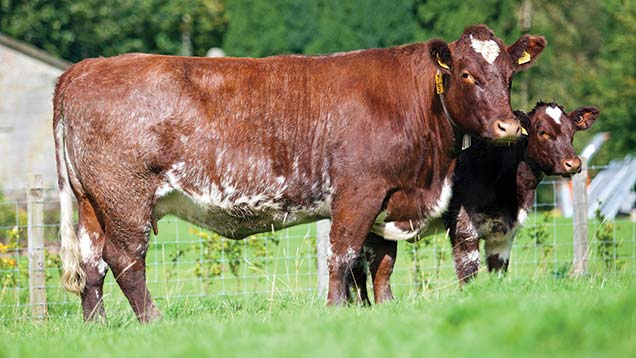New beef classification scheme will improve accuracy when buying bulls

A new beef type classification scheme, which is hoped will equip buyers of bulls with information on the maternal traits of cows has been launched by the Beef Shorthorn Society.
The initiative, which is believed to be the most comprehensive in the beef industry, will mirror the system used in the dairy sector. It is designed to identify females with strong maternal traits and good structural soundness.
See also: Farmers earn a price premium from Beef Shorthorn
The voluntary scheme will be free to all society members for at least the first two years and will be delivered by independent classifiers from Holstein UK.
The system will consist of two parts. The first part comprises a 14-trait linear classification, which will score the cow on a scale of 1-9 for structural soundness.
“Introducing the classification scheme will help to speed up breed improvement by enabling breeders to more readily identify females with the strongest maternal traits within their respective herds, along with good conformation and structural soundness”
Frank Milnes
The second part, called the composite classification, will comprise of a more subjective assessment looking at desirable traits in four categories – body confirmation, beef character, legs and feet and mammary, which when added together provide the animal’s final score.
This final score together with the ranking – from poor to excellent, will be automatically added to the animal’s name and made visible on pedigree certificates, Breedplan records and sales catalogues.
Frank Milnes, secretary of the Beef Shorthorn Society, hopes the scheme will be a huge step forward for the industry.
He says: “Introducing the classification scheme will help to speed up breed improvement by enabling breeders to more readily identify females with the strongest maternal traits within their respective herds, along with good conformation and structural soundness.
“It is just another piece of information the breeder will have to select their best cows. And I expect bulls out of ‘excellent’ classified cows will be highly sought after,” he adds.
The score will not be used in the calculation of EBVs, but can be used in conjunction with them to give a more accurate assessment of the type of cow that will be bred.
Mr Milnes says breeders wanting to get their cows classified must present all first-calved heifers for classification, but can get all their cows classified too. Only cows that have had three or more cows will be able to be classified as excellent.
He hopes out of the 550 registered members about 200-300 will have their cows classified over the next 12 months.
Beef farmer Sally Horrell, who runs the 55-cow Pode Hole in Peterborough, is getting her herd assessed later this month and believes type classification will help improve the herd.
She says: “Type classification will highlight areas that we need to focus improvement on and also the strong traits within our herd. We will then be able to identify where these traits have come from in our breeding programme and tweak these as we go forward, which is always our intention when purchasing the next stock bull.
“As a vendor and purchaser of breeding bulls, type classification will be an important part of our buying decisions. It is not always possible to get on farm to see the dam of a bull that we would wish to purchase, consequently in future, high classification scores throughout a dam line will give more confidence in the transaction,” she says.
